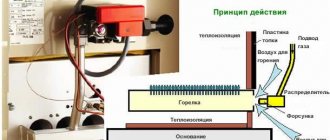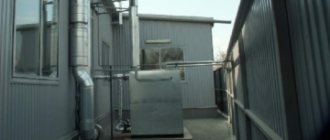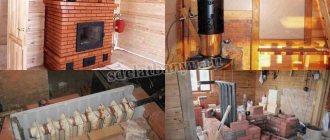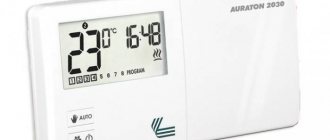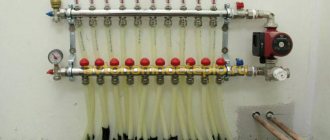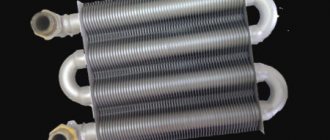Advantages
The advantages of gas boilers for heating for a private home usually include the following characteristics:
- Easy installation and operation. The organization of a gasified heating system involves the use of standard fasteners and connecting elements. They can be easily found in any hardware store, which allows you to install the equipment quickly and without much difficulty.
- Ability to carry out a certain amount of work independently. Such activities include purchase, assembly, selection of a suitable location and installation of the device. As for the startup and commissioning of gas heating boilers for a private home, this is allowed to be done only by specialists with the appropriate qualifications and permission. After commissioning activities, the equipment is sealed.
- High level of efficiency of a private gas boiler house. If you include a circulation pump in the heating system for forced supply of coolant, this will allow you to heat a large area of the house in a short time. This is especially convenient in cases where the building is used irregularly.
- Economic factor. Gas boilers are characterized by a high level of efficiency, since gas in most regions of our country is one of the cheapest types of fuel. To calculate the estimated volumes for heating a house, a special formula is used, where 1 m2 of energy resource consumed is multiplied by the heated area of the building. However, it should be understood that purchasing a gas heating boiler only makes sense if there is a main gas pipeline located nearby.
- Fire safety. If you follow all the rules for operating gas equipment, fires are completely excluded. Thanks to the use of a special scheme for removing products of incomplete combustion during the operation of the boiler, the risk of burning is also reduced to zero.
- Availability of special sensors. This allows you to control the gas supply, burner operating parameters and temperature conditions, which makes the system completely safe, making it possible to leave it unattended for a long time.
- A small percentage of formation of harmful substances as a result of combustion. For this reason, the gas combustion process is considered to be the most environmentally friendly.
- Compact size of a gas boiler with high power. This allows installation of equipment without compromising the integrity of the interior. This is especially true for wall-mounted gas boilers for heating a private home, which have a beautiful design.
- Durability. Gas boilers can operate without problems for up to 20 years. The use of cast iron units increases this figure to 50 years (read: “What are cast iron gas boilers - types, differences, how to choose and install”).
When considering a gas boiler as an option for installing an autonomous heating system, you should take into account some of its disadvantages:
- Difficulty in completing documentation. The organization of gas heating is accompanied by procedures for coordinating all work with special government services involved in the development of a housing gasification project. Often these procedures are quite time consuming.
- Installing a heating gas boiler for a private home makes sense in houses with a total area of 100 m2 or more: in other cases, it is recommended to consider other options.
Generation of new AGV systems
Some units are produced at Russian factories. One of them is AOGV-23.2-1, which structurally looks like a household heating cylinder. It is used in houses with an area of 140-200 square meters. There is a unit with a lower heating power - approximately 100-140 square meters. Apart from power, these two devices are no different from each other.
Recently, a new system was released called AKGV (Combined Gas Water Heating Apparatus). According to the method of use, it is no different from AGV; it is used both for heating the house and for supplying hot water. But the design of the AKGV unit is different - instead of a pipe that goes inside the boiler, three steel sections are installed, which are stamped in a special way, they are mounted in a vertical position and connected into one chimney.
This device is rightly called “two in one”, because it initially heats the water using a coil, which is encircled along the entire contour of the boiler. The water flowing through the coil is used for domestic purposes, and in the boiler the water is heated for heating.
The newest models have an injection burner. It ensures gas combustion without residue and works even when the gas pressure drops.
Automation of the new AGV
This irreplaceable item fully controls water heating and consists of:
- Thermal sensor, which gives the system an idea of the current temperature;
- Electromagnet - valve control device;
- Thermocouples, which are installed next to the igniter and are responsible for generating electric current when heated from the torch;
- Traction sensor. It is installed in the chimney to control draft.
With proper adjustment, the automation unit will prevent sudden shutdown of the AOGV in the event of a breakdown or failure in the boiler settings, and most importantly, will extend its service life.
If we talk about the origins, this type of heating equipment was developed back in the 50s, due to the lack of central heating in villages, villages and small towns. Since then, AGVs began to systematically gain popularity, and soon most houses in the USSR began to be heated with them. Thus, this system, of course, after modernization and modifications, fits well into modern realities
It is only important to know how to choose AGV heating, remember the rules for handling this system and follow them, then the boiler will serve you much longer than its declared service life. After all, the system in which hot water circulates does not tolerate jokes and amateur activities. In general, this system is quite economical both in terms of funds and in terms of space occupied
And with the introduction of ACS (Automated Control Systems), its operation and maintenance does not cause any trouble at all. After proper setup, according to instructions or with the help of a specialist, the coefficient of intervention on your part becomes minimal, and guarantees warmth to your home
In general, this system is quite economical both in terms of funds and in terms of space occupied. And with the introduction of ACS (Automated Control Systems), its operation and maintenance does not cause any trouble at all. After proper setup, according to the instructions or with the help of a specialist, the coefficient of intervention on your part becomes minimal and guarantees warmth to your home.
Thermocouple check
In order to check the AGV-120 thermocouple, you should unscrew the union nut, which is located to the left of the solenoid valve. Then you need to turn on the igniter and use a multimeter to measure the value of the constant voltage at its contacts.
Removing thermocouple AGV-120Source tskl.ru
In a heated state, 25-30 mV should form. If the measuring device shows a lower value, the thermocouple has become unusable.
The final check is carried out as follows:
- The tube is disconnected from the magnetic tip.
- A multimeter measures the resistance of a heated thermocouple.
- It should be less than 1 ohm.
- If the multimeter screen displays 100 Ohms or more, a new one is installed.
The discrepancy between the values produced by a thermocouple and the real ones can occur for a number of reasons. The most popular are:
- The igniter nozzles are clogged, which affects the thermocouple heating temperature below the nominal value. It is easy to solve the problem; to do this, just use a soft copper wire to clean the igniter channel.
- Displacement of the thermocouple position relative to the flame. This affects the insufficient heating of its tip. To eliminate the defect, it is necessary to loosen the screw that secures the wiring next to the igniter and adjust the location of the tip.
How to repair an AGV-120 with your own handsSource images.ru
If the voltage of the thermocouple tips is normal, you should check the following nuances:
- Traces of oxidation and integrity of contacts at the junction of the draft sensor and thermocouple. If a malfunction is detected, fix it: create a new contact or clean the old (oxidized) one. When performing these manipulations, you should be careful, since the union nut is tightened by hand, since a strong clamp can damage the soft wiring.
- There is no break in the contacts of the electromagnetic winding. If a malfunction is detected, they are soldered. To check the functionality of the electromagnetic coil itself, you will need to disconnect it from the thermocouple wiring, press and hold the start button, and light the igniter. A voltage of 1-2 V is supplied to the electromagnetic contact (from a AA battery). If, after releasing the button, the igniter continues to burn, then no malfunctions were detected in the operation of the electromagnet and the draft sensor.
- Traction sensor performance. First of all, you should make sure the quality of the contact clamp and the bimetallic plate (in most cases, malfunctions in its operation occur precisely for this reason). To do this, you need to break the contact, clean the above-mentioned washer and wiring and reconnect. There is no need to make additional adjustments; if there is good contact, this will not affect the sensor response temperature in any way.
Service life of a floor-standing boiler
Floor-standing gas units last 5-8 years longer than wall-mounted ones. So, according to actual data, a steel heat exchanger can last 11-12 years, and a cast iron one can last 12-18 years.
Floor-standing devices practically do not function at full load, which prolongs the service life. And if the owner of a double-circuit heating boiler carefully carries out all routine maintenance and preliminary water purification, then such a gas boiler unit will serve him for at least an additional ten years. Many people remember Soviet cast iron boilers with a service life of 50 years.
At temperatures below 55 C, the condensation process begins in them, with the formation of acid, which penetrates the boiler heating surfaces and “eats away” everything in its path, from the chimney system to the firebox.
Therefore, if the manufacturer specifies a lower temperature limit for the return coolant, it must be maintained. In addition, when the condensation process occurs, it is necessary to additionally install condensate traps at the bottom of the chimney, which will significantly increase the service life of the floor-standing gas boiler.
How does AGV work?
The design of the AGV heating boiler is quite simple, as can be seen in the photo - outwardly the boiler resembles a samovar. There is a pipe in the container, and water is poured into the space between the walls of the pipe and the walls of the container, which will be the coolant. The gas that is burned in the boiler furnace passes through the tube and gives off its heat to it. And the pipe gives off heat to the water in the tank, after which the water begins to move upward along the heating riser.
AGV heating
Modern AGV gas heating boilers are equipped with an automatic device, which is not only responsible for the optimal gas supply to the burner, but also controls the state of such supply. And the control process itself is also simple: a special temperature sensor is installed in the device’s container, monitoring the temperature of the coolant. When the desired value, which is previously set, is reached, the automatic damper is activated. It shuts off the gas supplied to the burner, but the wick remains burning. If the coolant temperature drops, the sensor is triggered, the gas supply is turned on, and then it is ignited from the wick.
Features of operation
During the installation, operation and use of the AGV boiler, the following nuances arise:
- When the device starts up, a characteristic bang occurs (in the most modern devices it is almost silent);
- The AGV chimney must be installed at a certain distance from windows and doors;
- Under the chimney you need to install a garbage container, which needs to be cleaned every time you install the boiler;
- Only gas service employees can install and put the boiler into operation;
- When installing the device, the requirements described in the documentation supplied with it must be observed.
How the AOGV boiler works
The main change in the design of AOGV boilers was the presence of a modern automatic control system, which still operates without being connected to the electrical network.
AOGV boilers, just like their predecessors, are a tank filled with water, which is heated by a burner installed at the bottom of the tank. Bottom heating creates powerful convective upward currents, which are removed from the heating boiler through a pipe in its upper part.
The heated flue gases enter a fire tube heat exchanger passing through the central part of the boiler and connected to the chimney. The coolant is also heated through the walls of the heat exchanger, with which the water in the boiler comes into contact.
This device ensures boiler efficiency of up to 89%. An interesting feature: with an optimal ratio of draft and pressure in the gas pipeline, the efficiency of the boiler can be significantly higher than that declared by the manufacturers.
Cold water from the heating system enters the boiler by gravity, therefore, during installation, the AOGV boiler is located at the very bottom of the heating system, sometimes artificially lowering its location.
The burner is ignited from the igniter. An indispensable condition for combustion is the presence of draft, to control which the boiler is equipped with a draft sensor. In the absence of traction, the gas supply is automatically turned off. Typically, if there is insufficient vacuum in the chimney or if it is blown out by the wind, the gas supply to the combustion zone is completely blocked. The pilot light also stops burning.
A thermocouple is used to control the heating level of the coolant. When the coolant heats up above the set value, the gas supply is turned off. When the temperature of the coolant decreases, gas combustion resumes.
Such a simple automatic boiler control system does not provide a constant level of temperature in the room and does not allow changing heating modes at home, but it works in any conditions, which allows the use of AOGV boilers in areas with power outages or without any connection to it.
The AOGV automatic boiler control system performs the following functions:
- Blocks the boiler in the absence of draft
- turns off the burner when the coolant overheats and resumes combustion when the boiler water temperature drops
- blocks the gas supply when the pressure in the supply gas pipeline decreases or when it pulsates
- Blocks gas supply in case of thermocouple malfunctions
Speaker repair
AGV – 80 gas heating boiler. Technical characteristics of agv-80:
- Heat load 6000kcal/h
- Water temperature setting 40 - 90gr/C
- Heated room area up to 60m2
Main components of the AGV-80 heating boiler.
- Galvanized tank (80 liters), thermal insulation, min. cotton wool. In the center of the tank is a flame tube with a heat flow extender.
- The main burner, in front of it, the tap regulates the gas supply.
- Automatic security.
- For flame, solenoid valve, thermocouple, igniter.
- For draft, tee, connected pipe, draft sensor.
- Temperature-thermostat.
Boiler solenoid valve. The boiler solenoid valve consists of two parts: gas and electromagnetic. There is a membrane between them. The thermocouple consists of two metals, chromel and copel, welded together. The flame heats the boiler thermostat, generating an electric current that magnetizes the core. By pressing the start button, the armature is pressed against the core by a pusher, while the paired valves move inside the gas part, opening the gas to the boiler igniter and compressing the return spring. At the end of the thermocouple warming up for 60 seconds, you must smoothly release the boiler button; under the action of the return spring, the paired valves are shifted back - 2.3 mm. Gas opens to both the igniter and the main burner of the boiler. The valve cannot return completely to its original position. They are held by an anchor magnetized to the core. If the igniter goes out, then the thermocouple of the heating boiler cools down and the magnet releases the armature; the return spring pushes the valve to its original position, no gas flows to the burner.
Malfunctions of the gas heating boiler AGV-80
- Contamination of the surface of the core and armature (clean, degrease)
- Thermocouple burnt out (Replace)
- No electrical contact.
Automatic traction (with gas removal from the igniter)
Gas from the electromagnetic valve of the heating boiler flows through the tee to the igniter, as well as through the connecting tube to the draft sensor installed under the hood of the device. The draft sensor is a bimetallic plate with a plug, which, during normal draft, closes the gas from the connecting tube. When the draft is covered, combustion products come out from under the hood and heat the bimetallic plate. It unbends, the plug opens the gas from the connecting tube, and gas is supplied to the igniter. Response time from 10 to 60 seconds.
Gas boiler thermostat. Operation accuracy 5gC, thermostat parts.
- Frame.
- Toggle lever system.
- Valve with spring.
- A brass tube with an invectar rod is screwed into it.
- Lever for thermostat.
When the water in the tank is heated, the brass tube lengthens, but the intar rod does not. The rod moves behind the tube and stops pressing on the system of closed levers, which, under the action of a spring, closes the valve with a click, blocks the passage of gas to the burner; when the water cools, the brass tube shortens; the rod presses on the levers, they close and turn off the valve. When the setting lever is rotated counterclockwise, the response temperature increases.
Malfunction of the boiler thermostat.
- The thermostat does not work and cannot be adjusted: The lever system has stretched or burst.
- The large or small levers are deformed.
- The supporting edges of the levers are worn
The thermostat operates but does not stop the gas supply: The valve stem sets the guide bushing.
AGV, or automatic gas water heater, is an element of the heating system, thanks to which it becomes easy to operate along with a fairly long service life. However, the presence of these characteristics is possible only if the gas boiler is properly installed and properly maintained.
Epilogue
In conclusion, it is worth recalling that the repair of AGV, along with the maintenance of gas boilers, are quite difficult operations that must be carried out by specialists. Only by observing this condition can the risk of damage to housing and injury to its inhabitants be eliminated.
Repair of AGV, OAGV, gas heating boilers 8-903605-49-99
Operating principle of AGV
The main structural element of the AGV is the container in which the coolant is heated. When gas burns, a heat exchanger, made in the form of a pipe and installed inside the AGV housing, heats up. The heat from the heated pipe is transferred to the coolant, which is subsequently sent to the heating circuit.
Gas combustion products are discharged through a chimney built into the boiler design. All automation is a valve that opens the gas burner. Thanks to the operation of the valve, the required temperature is constantly maintained in the tank.
AOGV boilers also have an automation unit that turns off the device in case of a number of problems:
- Traction disorder;
- Significant reduction in gas supply pressure;
- The igniter stops burning.
- Expansion tank;
- Heating devices located in each room requiring heating;
- Main pipeline providing distribution of heated coolant;
- Upper pipe distribution;
- Return pipe.
To know how an AOGV gas boiler works, you need to imagine the physical laws that arise in the heating system during its operation. The heated coolant has a lower density, which allows it to independently rise above the cold liquid. The coolant enters the main pipeline, is carried through the heating devices, gives off heat to them, and returns to repeat the heating cycle.
In AOGV boilers, the liquid moves by gravity, without any additional effort. If during the heating process the coolant expands too much, then its excess is drained into the expansion tank. This element is installed on the uppermost section of the heating circuit. When the temperature in the circuit decreases, the coolant returns to the OGV gas boiler.
To increase the efficiency of the system and make it more stable, you can supplement the AGV with a circulation pump, which forces the coolant to move forcibly and ensures more uniform heating of all sections of the circuit. It must be remembered that the pump requires electricity to operate - and the main advantage of the AGV is its independence from electricity.
Scheme of water heating of a country house
To heat country houses, heating systems are installed in which water or antifreeze acts as a coolant.
The system consists of the following components:
- Water heating boiler (with two or one circuit).
- Polypropylene or metal fittings and pipelines.
- Bypasses that allow you to turn off individual radiators without stopping the entire system.
- Cast iron, steel, bimetallic or aluminum batteries.
- Expansion tank.
- Circulation pump (only in systems with forced circulation of the coolant).
- Gas heating equipment must be equipped with a safety system, which includes a thermocouple and a solenoid valve.
Depending on the wiring diagram, such systems can be single-pipe or double-pipe. In the first case, heating devices are connected in series, so the temperature of the coolant in each subsequent device decreases. This wiring is suitable for small one-story houses.
With two-pipe wiring, coolant with the same temperature is supplied to each radiator, which ensures uniform heating of the entire house. If necessary, individual radiators can be disconnected from the general circuit. This wiring is ideal for a large house with several floors.
Depending on the principles of coolant flow, systems come with forced and natural circulation. With forced current, a circulation pump is responsible for the movement of liquid through the pipes, and natural circulation occurs due to the different densities of cold and hot liquid.
The expansion tank can be open or closed. For systems with natural circulation, an open type container is used. A closed tank with two sealed parts separated by a membrane, used in systems with forced liquid flow.
For small one-story buildings, systems with natural current are sufficient, but for buildings with several floors, a pump will have to be installed. In this case, the length of the circulation circuit is limited to 30 meters, because the pump will not be able to supply water over a greater distance.
You can also install combined heating. In such systems, the pump is installed on the bypass. It starts up when you need to quickly warm up the premises. If there are interruptions in the power supply, then by simply switching the levers you can switch to heating with natural circulation.
Wall unit electronics
A special feature of these heat generators is electronic control of the processes of ignition, combustion and maintenance of coolant temperature. That is, wall-mounted gas boilers (and some floor-standing ones) are equipped with energy-dependent automation powered by electricity.
An automatic gas boiler was created for maximum convenience for owners of apartments and private houses. To start the heater, just press 1 button and set the desired temperature. Let us briefly describe the operating algorithm of the unit and the elements involved in it:
- After these startup steps, the heat generator controller collects sensor readings: coolant and air temperature, gas and water pressure in the system, and checks the presence of draft in the chimney.
- If everything is in order, the electronic board supplies voltage to the electromagnetic gas valve and at the same time a discharge to the ignition electrodes. The wick is missing.
- The main burner ignites and gives full power in order to heat the coolant as quickly as possible. Its operation is monitored by a special flame sensor. The controller includes a built-in circulation pump.
- When the coolant temperature approaches the set threshold, which is recorded by the overhead sensor, the combustion intensity will decrease. Staged burners switch to low power mode, and modulating burners smoothly reduce the fuel supply.
- Having reached the heating threshold, the electronics will shut off the gas. When the sensor detects cooling of the water in the system, automatic ignition and heating will be repeated.
The instructions for the wall-mounted gas boiler indicate that the unit is designed to operate in a closed heating system, so the automation monitors the water pressure. If it drops below the permissible limit (0.8-1 Bar), the burner will go out and will not light until the problem is corrected.
Many imported boilers operate according to an energy-dependent scheme, for example, Buderus Logano, Viessmann and so on. How the installation of electronic gas equipment occurs, the master will tell you in an accessible language in the video:
Technical parameters of AGV boilers
| Options | Boiler type | |
| AGV-80 | AGV-120 | |
| Thermal power, kW | 7 | 14 |
| Heating capacity, kW | 5.7 | 11.3 |
| Tank capacity, dm3 | 80 | 120 |
| Water heating time up to 90 0С, min | 60−70 | 60−70 |
| Heating temperature range, 0C | 40−90 | 10−90 |
| Heated area, m2 | up to 60 | 85−100 |
| Efficiency, % | 75 | 75 |
Currently, units such as AOGV (gas water heating apparatus) and AKGV (complex gas water heating apparatus) are widely used, which replaced the AGV-80 and AGV-120. The most widely used models are AOGV-17.4−3 (designed for heating rooms with an area of 100 - 140 m2) and AOGV-23.2−1 (designed for heating rooms with an area of 140 - 200 m2). The most advanced device is considered to be the AKGV-23.2−1, which allows heating a room with an area of 140 - 200 m2, as well as organizing hot water supply.
As a rule, residents choose dual-circuit units. With all their advantages (heating and hot water, low cost, efficiency), they have one drawback - the need for 220 V electricity.
Among people with average and higher incomes, AGV boilers produced by well-known foreign companies are becoming increasingly popular:
- BAXI and FERROLI (differ in design and setting parameters electronically);
- RINNAI (Japanese quality and reliability, simplicity and ease of use);
- ANIERIA (Korean economy class boilers, high reliability, relative cheapness).
Although imported units are more efficient than domestic ones, they all require an electrical connection. For Russian conditions, with frequent power outages, especially in remote areas, this circumstance often becomes decisive when choosing a boiler. Another significant factor influencing the choice of boiler model is its price and operating costs. Our boilers are several thousand rubles cheaper and their operation costs on average 35% less. Therefore, most consumers prefer domestically produced products.
Since gas is by far the most accessible and cheapest energy resource, the arrangement of space heating using AGW is becoming increasingly widespread
At the same time, the autonomy and relative low cost of operating the equipment are of no small importance.
AGV design
The principle by which the most common model of those times, the AGV 80 gas boiler, operates, is very similar in its simplicity to an ordinary kettle of water placed on a gas stove. A primitive round-shaped burner was installed under the mouth of one vertical steel pipe ending at the top with a chimney pipe.
There were no traces of any copper or steel heat exchangers on the 80th model and the more powerful AGV 120; the only flame tube was immersed in a cylindrical tank of water, as shown in the diagram:
To slow down the speed of exhaust gases, a turbulator was placed inside the pipe, due to which the efficiency of the installation slightly increased. As can be seen from the diagram, the device was equipped with an automatic system that shuts off the gas supply to the main burner when its pressure decreases or the water heats up to a certain temperature. The more powerful AGV 120 boilers generally had the same design, as can be seen in the figure:
Here the burner power and unit dimensions are larger, in addition, the temperature sensor here is not an ordinary brass tube with an Invar rod, but a thermal cylinder. The kerosene expanding in it through a capillary tube affected the gas valve mechanism, closing it if necessary. General technical characteristics of the AGV 80 and 120 boilers are reflected in the table:
Modern AGV boilers (which stands for automatic gas water heater) of course have a more reliable and efficient design. The flame pipe is now divided into several sections with turbulators in each, and to prepare water for the needs of domestic hot water, a coil is installed in the water jacket of the apparatus. The details are clearly visible in the diagram:
The gas valve, thermostat for the boiler and the entire automation kit are also modern. In budget modifications, Russian-made devices are installed, and in more expensive ones, Italian ones. They are designed to shut off the gas supply to the main burner if:
- the draft in the chimney will disappear, for which the corresponding sensor is responsible;
- the flame breaks off or the burner goes out spontaneously;
- The gas pressure in the main has dropped.
Note. Also, the gas supply stops when the coolant temperature reaches the set value. In a word, in the updated AGV units for a private home, all systems function in the same way as in conventional gas boilers. The only difference is in the organization of heat exchange.
general description
AGV gas boilers have always been characterized by rather low efficiency, but this is not so important if gas is the cheapest fuel. Old models of autonomous water heaters were equipped with very unreliable automation, which could completely fail within a few years. Of course, it could always be turned off, and this did not affect the performance of the boiler in any way - but positive emotions could not arise because of this.
When choosing an AGV for a private home, it is necessary to correctly select the number and sizes of main pipes. Their minimum diameter is two inches. If the diameter of the pipes is smaller, then, firstly, their throughput will not be enough, and secondly, air pockets and water turbulence will form in the line, interfering with the normal circulation of the liquid.
The use of wide pipes, in turn, leads to a significant increase in the amount of coolant in the circuit. A large volume of liquid means more energy spent on heating. This feature must be taken into account when designing a heating system powered by AGW.
There are several modifications of standard AGV models. Thus, on the market you can find devices of the AOGV type - essentially, all the same AGVs with a similar set of negative qualities. The difference between a boiler and an AOGV will be discussed below. In addition, there is a modification of the AOCGV, which also does not have significant differences from the devices described above.
System installation
All installation work begins after the project has been drawn up and approved by the relevant organizations. The technical specifications for the design are issued by the gas industry. The main requirements in it are for the room in which the boiler will be located.
Particular attention in the technical specifications is paid to general ventilation, the installation of chimneys, and the presence of gas analyzers. The distances from the walls when installing equipment are also regulated.
Connecting the boiler to the heating system.
It is necessary not only to study how the system works before purchasing it, but also to consult with specialists whether it is possible to install the unit in the intended location.
Where installation is possible
Despite the fact that it is recommended to install the AGV on the floor in a separate room, this does not exclude the possibility of installing such a boiler in the kitchen of a residential building or apartment, provided that the relevant requirements are met.
Wall-mounted gas boilers of this type are used very rarely, and even then after significant alterations, as a result of which their classification as traditional AGV is very conditional. Consulting with a specialist will help you choose the optimal location and type of boiler.
Pipeline layout
This type of heating system is open and is installed with overhead piping. Moreover, it can be single-pipe or double-pipe. Which one to choose is decided in each specific case individually.
Installing a two-pipe system allows you to turn off heating appliances using shut-off valves, but then the circulation resistance of the coolant increases sharply. Without the use of a pump, this can create problems during the operation of the heating system of an apartment or house.
Nuances of pipeline installation
During the installation of pipelines, an expansion tank is installed at the maximum possible height, which will accept the excess volume of water when it is heated. An overflow pipe is welded into it.
The diameter of the pipes for water supply and return drainage must be at least 50 mm. Such a significant increase in size is necessary to reduce the coolant resistance. They are installed with a slope to avoid air pockets.
Slope Options
The optimal slope is 1:100. The direction of the slope of the upper (supply) manifold is downward from the expansion tank to the first radiator. The lower (return) pipeline must have a slope from the last radiator to the AGV. Mayevsky taps are installed in the upper plugs of heating radiators, and the make-up tap is installed in the return line.
System layout.
Installation
The outer part of the chimney and the part located in the attic must be thermally and waterproofed.
It is necessary to install an inspection in the chimney designed to collect debris that has entered the chimney. Modern gas water heating installation.
Gas heaters can be connected to the gas pipeline and registered only by representatives of the regional gas industry. It is imperative to thermally insulate the pipeline through which the coolant will flow to the radiators. But it is not necessary to subject the return circuit to this procedure. If the house uses a heating circuit with natural circulation of coolant, the device should be mounted below the place where the radiators are installed. It is recommended to install it in the basement.
Installation of harness
In the process of installing gas heating, it is important to correctly set the angle of inclination of horizontal sections of the pipeline. The requirements include 1 cm of slope per 1 m of pipeline length
This allows for more efficient fluid circulation, reducing the likelihood of air locks. Providing the required slope will help drain water from the system if it is intended to preserve or repair individual elements.
AGV installation process.
The heating system will have a shorter service life if the temperature exceeds +50 °C, as this will cause condensation to form on the walls of the pipes and boiler. To improve the performance of systems using gas heat sources, heating can be supplemented with a circulation pump.
Advantages and disadvantages of equipment
Both types of gas boilers are easy to operate, efficient and durable. They also have an attractive appearance.
The design of each type of gas boiler is designed to meet the needs of different categories of users, which clearly demonstrates their advantages and disadvantages. They also provide an opportunity to understand the differences between a single-circuit gas boiler and its double-circuit counterpart, helping the potential buyer make the right choice.
Pros and cons of single-circuit units
Such products are capable of providing stable heating of rooms of any size, number of floors, and distance from the heat exchanger.
And, in addition, single-circuit boilers:
- more reliable than their double-circuit counterparts, the design of which is more complex, which leads to a slightly larger number of breakdowns;
- easier to maintain, which is also caused by design features;
- cheaper.
An important advantage is that single-circuit units can become the basis for connecting other equipment. This will expand their functionality and increase the comfort of living.
You should always remember that if you need to provide hot water supply in the premises, you will have to buy a storage boiler together with a single-circuit boiler. And this will lead to considerable additional costs. And a set of the listed equipment will take up a lot of space, which can be critical for small apartments
Connecting storage boilers will provide the premises with hot water supply. Moreover, the water will be supplied hot at any time, which is not always possible to achieve from dual-circuit analogues
This type of equipment, in the absence of the need for hot water supply, has no pronounced shortcomings. But otherwise, the lack of universality immediately affects. Which leads to the need to purchase an additional electric heating device.
As a result, its joint operation with a single-circuit boiler leads to:
- high costs for purchase, installation, maintenance;
- limited volume of water for domestic needs - boilers are most often purchased for joint use with single-circuit units, so the question may arise about the rational consumption of water, the volume of which depends on the capacity of the storage tank;
- greater load on the wiring.
The last drawback is relevant in cases where the house or apartment has old wiring or powerful electrical equipment is used in parallel. So, it may be necessary to modernize the electrical wiring and select a cable with a larger cross-section.
You should also be aware that a set of a single-circuit boiler and a boiler takes up significantly more space than one double-circuit boiler. And with limited space this can be a significant disadvantage.
Advantages and disadvantages of double-circuit boilers
Units that belong to the specified type have some restrictions, but are still capable of providing hot water to two systems at once (heating, hot water supply). They also take up less space than their boiler counterparts. As a result, double-circuit boilers are more convenient to use.
Both types of gas boilers are easy to operate, efficient and durable. They also have an attractive appearance.
In addition, the competitive struggle of manufacturers has led to the fact that the difference in the cost of both types of units is gradually leveled out.
Therefore, today you can find a double-circuit boiler whose price is slightly higher than that of a single-circuit product. Which in some cases can also be considered an advantage.
If we talk about the disadvantages of double-circuit boilers, the most important is the inability to instantly provide hot water of the same temperature to all water consumption points in a house or apartment.
So, in their heat exchangers the amount of water that is needed right now is heated. That is, no stock is created. As a result, the water temperature may differ from what you expect or may change as you use it. This happens when the pressure or pressure changes, for example, after opening/closing the second tap.
When using a double-circuit boiler, the water temperature often differs at two different water intake points - hot water can be delivered to the desired point with a significant delay. Which is inconvenient and leads to additional costs
As for installation, installation of double-circuit boilers is a more complex procedure, especially at the design stage. Since you will have to follow numerous manufacturer’s recommendations
Let's consider the method for finding the above fault.
When repairing a gas boiler, testing begins with the “weakest link” of the automation device - the draft sensor. The sensor is not protected by a casing, so after 6...12 months of operation it becomes “overgrown” with a thick layer of dust. The bimetallic plate (see Fig. 6) quickly oxidizes, which leads to deterioration of contact.
The dust coat is removed with a soft brush. Then the plate is pulled away from the contact and cleaned with fine sandpaper. We should not forget that it is necessary to clean the contact itself. Good results are obtained by cleaning these elements with a special “Contact” spray. It contains substances that actively destroy the oxide film. After cleaning, apply a thin layer of liquid lubricant to the plate and contact.
The next step is to check the serviceability of the thermocouple. It operates in severe thermal conditions, since it is constantly in the flame of the igniter; naturally, its service life is significantly shorter than other elements of the boiler.
The main defect of a thermocouple is burnout (destruction) of its body. In this case, the transition resistance at the welding site (junction) increases sharply. As a result, the current in the Thermocouple - Electromagnet circuit.
The bimetallic plate will be below the nominal value, which leads to the fact that the electromagnet will no longer be able to fix the rod (Fig. 5).


